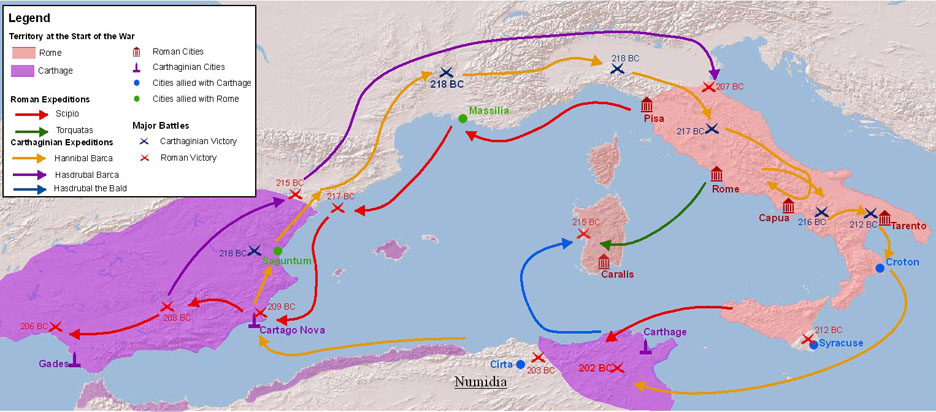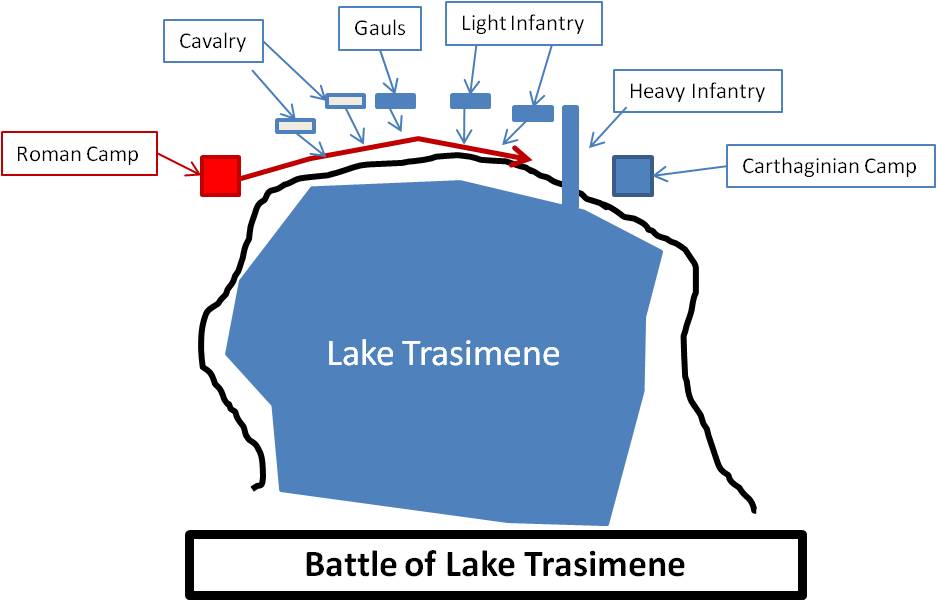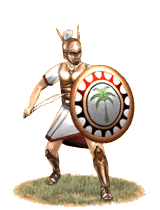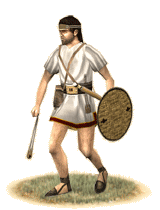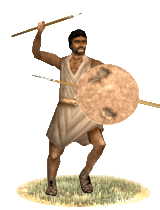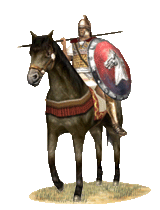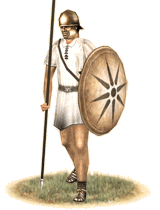At the end of the First Punic War, both the Romans and the Carthaginians had lost 500-600 ships and 200-250 thousand troops in battles alone, to include the losses in storms would double these numbers (Life Time Books). Carthage, who was the naval power of the Mediterranean, had been humiliated by a nation unused to Naval warfare. However, the Carthaginians were not to be deterred. They soon took the lands of Algeria and Morocco, new land bases for their overseas campaigns in Spain. This is where Hannibal learned the art of war at the teachings of his father, Hamilcar Barca, who was the General in the first Punic War (Rickard, J). After seventeen years, the stage was set for Hannibal, who was by now a general and master tactician in the Carthaginian army to invade Italy.
The spark for this second war between Rome and Carthage was the siege and capture of the city Saguntum, who was an ally of Rome, at the command of Hannibal (Rickard, J). Rome, after sending envoys to Carthage, declared war on Carthage in the year 218 B.C. (Life Time Books). Hannibal who had prepared for this in the years before, gathered his forces of about 48,000 infantry and 8,000 cavalry head headed to northern Spain.(life Times Books). Hannibal also had with him forty War Elephants, the main purpose of these elephants was to impress the Gallic tribes, so that they might join Hannibal in the war against Rome. Hannibal then took his army and traveled through open roads of the Appalachian Mountains, his army would have been freezing and were continually harassed by tribes living in the passes. When he finally came through the treacherous mountains he only possessed 38,000 infantry and 6,000 cavalry as well as 25 of his elephants (Life Time Books).
The time that it took Hannibal to cross the mountains gave Roman scouts a chance to fallow his movements and when he finished navigating the passed there was a Roman force sent to intercept him, Hannibal had no choice but to fight. The force was led by Consul Publius Cornelius Scipio who had camped by the Ticinus River, Scipio had decided to test Hannibal's strengths and attacked with his cavalry in the Battle of Ticinus(Nov. 218 B.C.). Hannibal responded in kind, but outnumbering his enemy and winning with a superior cavalry, Scipio was injured in this conflict and forced Scipio to retreat (Rickerd, J). This was the first notable conflict on Italian soil that also gave Hannibal some leeway with the negotiations for allies from the Gallic tribes. All of the Gallic tribes join him except the Cenomani people, giving most of Northern Italy the brand of insurgents. Hannibal now short on supplies, starts to raid and forage in the Italian countryside, after collecting the supplies needed Hannibal decided to march south. The Romans in response to this defeat and movement of Hannibal,sent two forces, one on the west coast to protect the cities and one to the Apennine passes to stop Hannibal from going towards the east and hopefully bottling him into northern Italy. Despite rapid movement on the Romans part, Hannibal was still able to make it through the passes without opposition, and started to move toward the heel of the Italian “Boot” where he continued to win battles like the Ambush of Lake Trasimene using his wits and skills as a commander, securing more friends from the Gaul’s and Roman “Allies”(Rickerd, J).
The Second Punic War wasn't just fought in Italy, but also in Spain,where the Romans under the Command of Consul Scipio were able to take the Carthaginian held lands. The Roman Armies in Spain were doing well until 211 B.C. where they got overconfident and lost. In Response to this defeat, the Roman Senate sent Scipio with 10,000 infantry and 2,000 cavalry, and when Scipio arrived in Spain was able to rally another 15,000 infantry and 5,000 cavalry from the past Roman defeat. Scipio quickly got to work capturing New Carthage, an important Carthaginian city that held control in it's surrounding lands of Spain. The Carthaginian forces in Spain were also separated from each other and didn't always act as one army but as separate forces, this weakened them substantially. This allowed Scipio to defeat each of them in relative ease, as he was able to surprised two of the generals by having a better system of scouts than the Carthaginians. By 203 B.C. Scipio had taken Spain from Carthaginian rule.
The Second Punic War wasn't just fought in Italy, but also in Spain,where the Romans under the Command of Consul Scipio were able to take the Carthaginian held lands. The Roman Armies in Spain were doing well until 211 B.C. where they got overconfident and lost. In Response to this defeat, the Roman Senate sent Scipio with 10,000 infantry and 2,000 cavalry, and when Scipio arrived in Spain was able to rally another 15,000 infantry and 5,000 cavalry from the past Roman defeat. Scipio quickly got to work capturing New Carthage, an important Carthaginian city that held control in it's surrounding lands of Spain. The Carthaginian forces in Spain were also separated from each other and didn't always act as one army but as separate forces, this weakened them substantially. This allowed Scipio to defeat each of them in relative ease, as he was able to surprised two of the generals by having a better system of scouts than the Carthaginians. By 203 B.C. Scipio had taken Spain from Carthaginian rule.
A battle in July 216 B.C. would be the turning point of this war; after achieving a major win at the Battle of Cannae and giving the Romans the worst defeat in their military history, Hannibal decides against marching on Rome. This Defeat changes the plans that the Romans had for winning this war, after re-discussing the war plan the Senate gave Scipio a doubled force, he marched down Spain and toward Carthage to attack the enemy at their heart. After being in Italy for 13 years, Hannibal was called back to defend the homeland from the Roman threat. Hannibal went to confront Scipio what would be called “The Battle of Zama”, and also the defeat of Hannibal.
